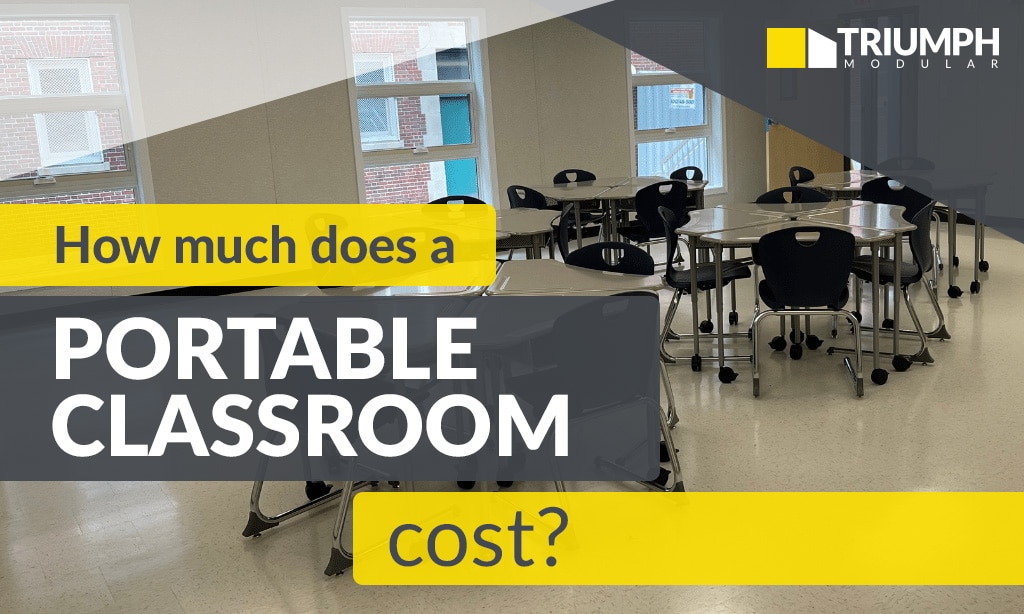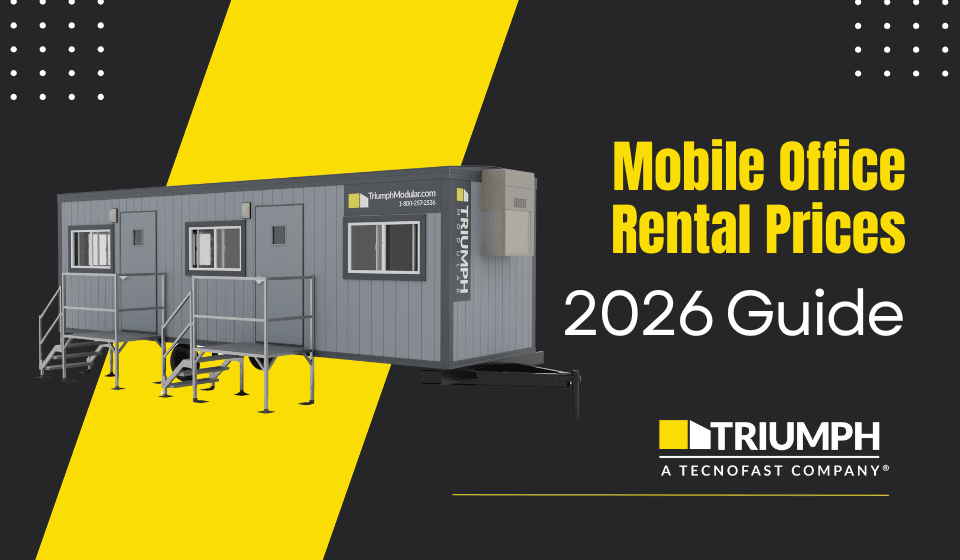For schools in need of additional space, whether it’s for overcrowding or other needs, modular classrooms provide a simple solution with many benefits.
We also understand that many building managers working in the education sector might not know the benefits of modular classrooms and what they entail. That’s why we’ve put together this FAQ with questions that we receive regularly about modular classrooms.
Let’s dive in and answer the most common questions we get!
Table of Contents
General Modular Classroom Questions
What is a modular classroom?
What are the benefits of modular classrooms over traditional construction?
How much does a modular classroom cost?
What is the lifespan of a modular classroom?
How long does it take to install a modular classroom?
What are the maintenance requirements for a modular classroom?
What amenities and features can be included in a modular classroom?
Are modular classrooms suitable for different grade levels and educational programs?
Are modular classrooms suitable for temporary and long-term use?
Can modular classrooms be leased or purchased?
How much space do you need in your modular classroom?
Are there any limitations on the size of a modular classroom?
Can modular classrooms be expanded in the future?
Can modular classrooms be more than one story?
Permits for Modular Classrooms
Do modular classrooms comply with building codes and regulations?
What is the process for obtaining permits and approvals for a modular classroom?
General Modular Classroom Questions
What is a modular classroom?
Modular classrooms are classrooms built off-site and assembled on-site. They can be standalone buildings or multi-unit buildings, depending on the needs of the school.
The modular process starts in a factory setting, where the units are assembled using standardized building practices. From there, modular classrooms are transported to the site. Because the build takes place off-site, some of the on-site preparation work can be done at the same time.
What are the benefits of modular classrooms over traditional construction?
Modular classrooms provide several benefits over their traditionally-built counterparts, including:
- Faster speed to occupancy – Since both off-site and on-site work can take place at the same time, this dramatically reduces the time it takes to get the building ready.
- Lower site impact – The modular building process largely relies on off-site construction in a factory setting, meaning that schools can eliminate much of the site impact with modular construction. There’s still on-site work to be done, but it will be far less disruptive than building the entire project on-site.
- Flexibility – Modular classrooms, particularly temporary ones, provide schools with a flexible solution as needs begin to shift. Instead of being locked into one specific use case, temporary modular classrooms can be repurposed or relocated elsewhere to tackle new challenges.
- Cost Predictability – Modular classrooms aren’t always the cheapest option. However, what they do offer is cost predictability. As long as design changes are kept to a minimum, costs remain stable, and the quotes provided at the start of the project are accurate.
- Reduced Waste – Modular contributes to eco-friendly construction practices in several ways. For example, a controlled factory environment means less waste—materials won’t be damaged by the elements, and unused pieces can be recycled or reused in future builds.
How much does a modular classroom cost?
Costs for modular classrooms vary on several factors. Some of these include:
- Whether it’s temporary or permanent
- Size
- Site work
- Setup and integration with other buildings
- Rental duration (if it’s a rental)
- The complexity of the build
For example, at Triumph Modular, you can expect a baseline price of $275 to $300 per square foot for rentals and $475 to $525 per square foot for purchased buildings. This price would include some of the factors listed above, such as delivery, setup, site prep, and site work. However, this price can also go up based on the build-out and finishes chosen. It’s around a 60/40 split for the cost of the space versus the other costs.
What is the lifespan of a modular classroom?
Modular classrooms are held to the same standards as stick-built classrooms, meaning that they will last just as long as classrooms built through traditional construction.
If properly maintained, the classrooms could last 30-50 years. Many of our clients have had modular classrooms for a decade or more.
How long does it take to install a modular classroom?
In general, you should budget at least 8 weeks from the shipping date to the end of the installation process.
However, the timeline for acquiring a modular classroom building typically begins much earlier than that—usually in the previous summer. The winter preceding installation is used for design planning, acquiring the materials, and constructing the building itself off-site.
What are the maintenance requirements for a modular classroom
No special maintenance is needed for a modular classroom more than for any other type of building. However, we do have some recommendations based on our experience:
- We recommend that the HVAC filters are inspected and changed at a minimum of every 3 months. If any work needs to be done to the coils or contactors to remove excess dirt, a professional HVAC technician should be used.
- For a lease, we ask that the client doesn’t use nails on the interior or exterior walls. We suggest renting whiteboards and cork boards instead.
- The classroom units should never be moved or relocated by anyone other than a Triumph Modular team member.
- In New England, we can receive heavy snow, so when we receive more than 6 inches of snow, removal with a plastic shovel is recommended. This helps prevent any potential leaks and water damage.
- Triumph Modular maintains a warranty that covers all mechanisms to work properly in the building. Any damage incurred by the customer will result in a chargeback for service completed by Triumph Modular.
- Regular janitorial service is also recommended (sweeping, dusting, wiping down surfaces, pest control, etc.)
What amenities and features can be included in a modular classroom?
This will come down to the configuration, design, and level of customization.
We can do almost any customization needed—electrical rooms, mechanical rooms, admin offices, and nurse’s offices could all be added.
There are other additional features that can be added, too. For example, some projects have included larger windows, upgraded HVAC systems, STEM classrooms, science labs, and even exterior siding to match any pre-existing buildings.
Depending on the size and location of the classrooms and the potential proximity to bathrooms at the main school, boy’s and girl’s bathrooms also may be needed.
Modular Classroom Use Cases
Are modular classrooms suitable for different grade levels and educational programs?
Yes, they are.
Modular classrooms can be used anywhere from K-12 and beyond, with some universities and colleges taking advantage of modular classrooms as well. There’s no age limit.
For example, Triumph Modular has provided modular classroom buildings for Hopkins Elmwood Elementary Schools and a science center for Wellesley College—two projects for schools on opposite ends of the age spectrum.
Are modular classrooms suitable for temporary and long-term use?
Yes, they are. Modular classrooms come in both temporary and permanent varieties. It all depends on your needs. For example, a school undergoing renovations and in need of space in the interim may opt for leasing a temporary modular classroom. Meanwhile, a school with overcrowding issues or specific needs, such as a science lab, may want to go the permanent or long-term route.
Can modular classrooms be leased or purchased?
Modular classrooms can be both leased or purchased, depending on your circumstances. Most of the time, permanent modular classrooms are purchased, and temporary modular classrooms are leased.
We view the break-even point in the 4-5 year range: If you intend to keep the building for 4-5 years or more, purchasing the building will likely be less expensive than renting.
Modular Classroom Sizing
How much space do you need in your modular classroom?
Here are some general guidelines:
- For education coded classrooms (K-12), the requirement is to have 20 square feet per occupant.
- For colleges and universities, the buildings don’t need to be education coded. Instead, they are typically business coded, and the requirement is to have a minimum of 100 square feet per occupant.
- For a traditional science lab, the requirement is 50 square feet per occupant.
For more information, you can consult the International Building Code (ICC).
Are there any limitations on the size of a modular classroom?
We can’t speak for other modular providers, but here’s what to expect from Triumph Modular regarding modular classroom sizing.
For leased portable classrooms, the size would be limited to availability from within the classroom fleet. If the leased portable classrooms are new from the factory, we’d suggest 14’ x 66’ (924 Sq Ft) or 14’ x 70’ (980 Sq Ft) modules. This allows for many different configurations of classroom layouts, depending on the total square footage and number of classrooms needed within the modular building complex. Typical classrooms within these modules are between 700 Sq Ft. and 850 Sq Ft. each, depending on the client’s specific needs.
For purchases and most permanent classrooms, there wouldn’t be any limitations on size. The client can choose the length and width of each module.
Triumph Modular has completed projects ranging from a single-room classroom to classroom projects that required 30-40 modules. There really is no limit to the size as long as there is usable real estate.
For more information, you can consult our classroom floor plans here: https://www.triumphmodular.com/classrooms/portable-classrooms/ and here: https://www.triumphmodular.com/glossary/floorplan-library-2/
Can modular classrooms be expanded in the future?
Modular classrooms are built as separate units, or “modules.” If expansion is necessary, most units can be expanded by adding an additional building to a pre-existing modular configuration—as long as the site itself allows for more modules to be added.
It’s also important to note that any additions would be considered another “project”, where project managers, engineers, architects, town permits, and building code inspections would need to be involved. Buildings in Massachusetts would need to be relabeled through the Manufactured Building Program, and if modular buildings are changed structurally, they will need to be inspected by a third-party inspection agency for final stamped buildings.
Can modular classrooms be more than one story?
Yes, they can. Multi-story classrooms would typically fall into the permanent category.
For example, Triumph Modular’s Hopkins and Elmwood Elementary project used four 14’ x 60’ modules stacked two over two.
However, when possible, we try to steer schools toward more simple layouts. Two stories would make a temporary setup more complicated than necessary, with fire escapes, stairs, elevators, and other necessary amenities.
Permits For Modular Classrooms
Do modular classrooms comply with building codes and regulations?
Modular classrooms are built to comply with the building codes and regulations of your state. Additionally, in the United States, all modular buildings must meet the International Building Code.
As long as you’re specifically purchasing or leasing a modular classroom from a reputable company, it will be up to date with building codes and regulations.
What is the process for obtaining permits and approvals for a modular classroom?
This will depend on the modular provider and the state where you’re located. In some cases, you may have to get permits yourself. Some of these permits include:
- Building permits
- Trade permits (mechanical, plumbing, electrical)
- Occupancy permits
- Road transportation/highway permits
As always, we recommend that people check with their local Building Departments, Planning Boards, and local government leaders for Zoning and Environment permit requirements in their region. However, if you choose Triumph Modular, we pull all of these permits for you.
For more information on modular classroom permits, here’s a list of helpful resources for each state in New England:
Learn More About Modular Classrooms in Our Guide
Looking for more information on modular classrooms?
Triumph Modular’s new ebook, the Guide to Modular Classrooms, has everything you need to know about modular classrooms and how to get started on your next classroom project.
Download our Modular Classroom Guide today!




